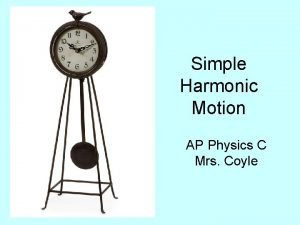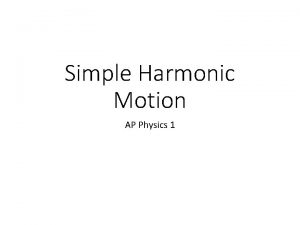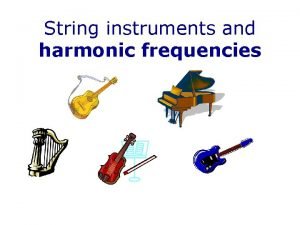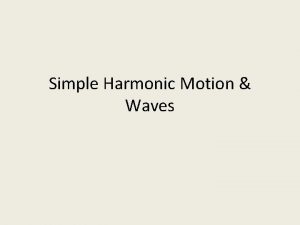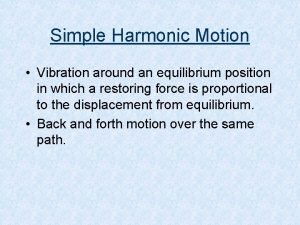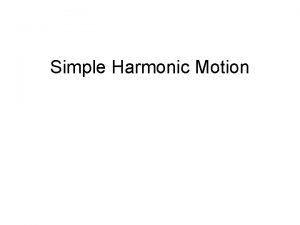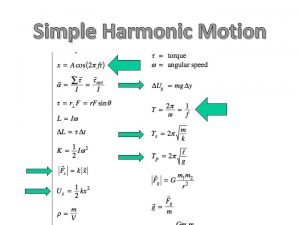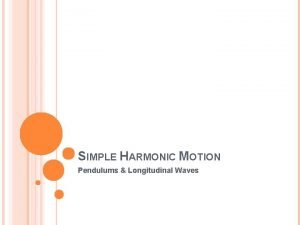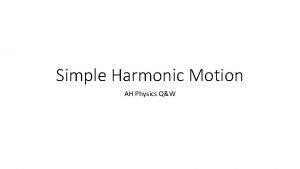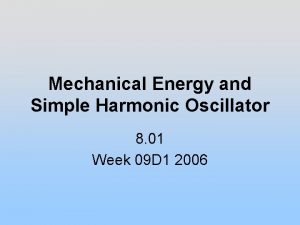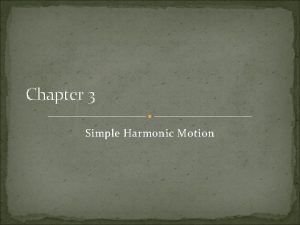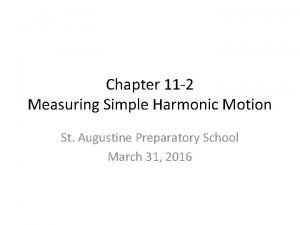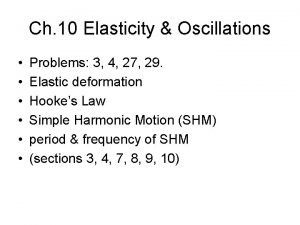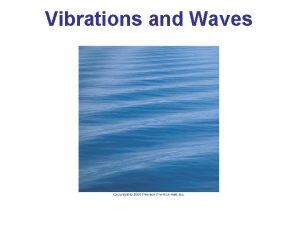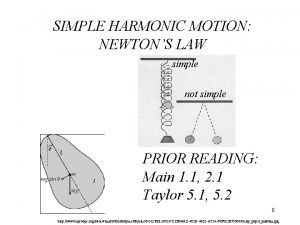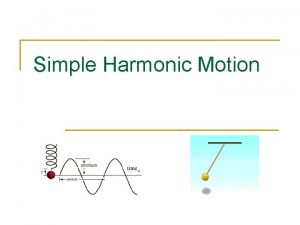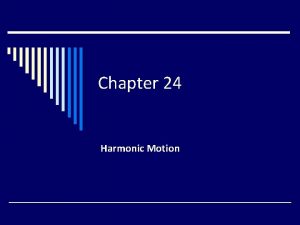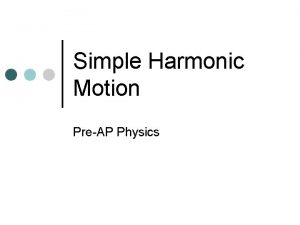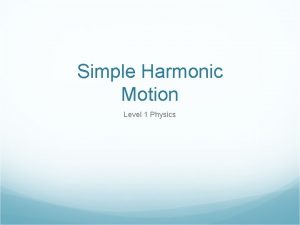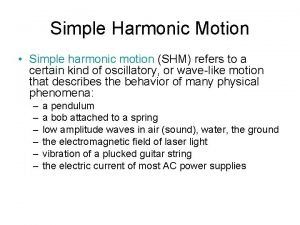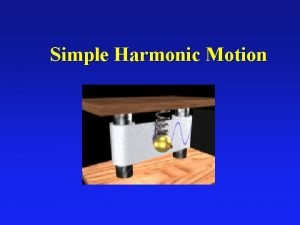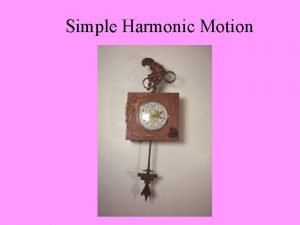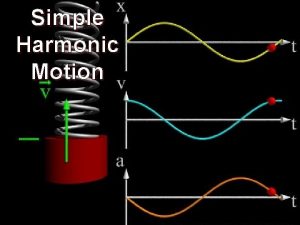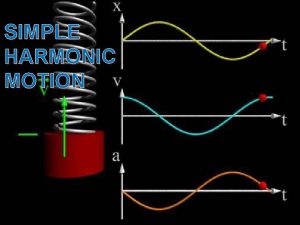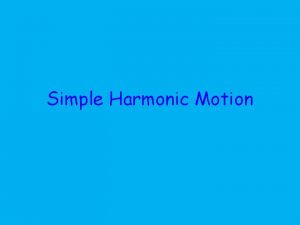Simple Harmonic Motion Level 1 Physics Simple Harmonic
















- Slides: 16

Simple Harmonic Motion Level 1 Physics

Simple Harmonic Motion When a force causes back and forth motion that is directly proportional to the displacement, it is said to be Simple Harmonic Motion

Hooke’s Law Easiest example of SHM would be Hooke’s Law k = Constant of Proportionality Spring Constant Units: N/m F = - kx Negative sign indicates that the force is in the opposite direction of the displacement “F” is a Restoring Force – object comes back towards equilibrium

Hooke’s Law In Hooke’s Law, you have to determine what force is stretching/compressing the spring. Examples are;

Example A load of 50 N attached to a spring hanging vertically stretches the spring 5. 0 cm. The spring is now placed horizontally on a table and stretched 11. 0 cm. What force is required to stretch the spring this amount? 1000 N/m 110 N

Hooke’s Law from a Graphical Point of View Suppose we had the following data: x(m) Force(N) 0 0 0. 1 12 0. 2 24 0. 3 36 0. 4 48 0. 5 60 0. 6 72 k =120 N/m

F vs. x again When you compress or stretch a spring, you must get something in return. In this case, the area under the curve is the energy. Area = Elastic Potential Energy FDx! Energy is stored when a spring is stretched/compressed. This type of energy is classified as Elastic Potential Energy (EPE).

Elastic Potential Energy The graph of F vs. x for a spring will always produce a linear line that has a positive slope (IDEAL spring!). Therefore the area under the curve will be a triangle.

Conservation of Energy in Springs

Example A slingshot consists of a light leather cup, containing a stone, that is pulled back against 2 rubber bands. It takes a force of 30 N to stretch the bands 1. 0 cm (a) What is the potential energy stored in the bands when a 50. 0 g stone is placed in the cup and pulled back 0. 20 m from the equilibrium position? (b) With what speed does it leave the slingshot? 3000 300 J 109. 54 m/s N/m

Springs are like Waves and Circles The amplitude, A, of a wave is the same as the displacement , x, of a spring. Both are in meters. CREST Equilibrium Line Trough Ts=sec/cycle. Let’s assume that the wave crosses the equilibrium line in one second intervals. T =3. 5 seconds/1. 75 cycles. T = 2 sec. Period, T, is the time for one revolution or in the case of springs the time for ONE COMPLETE oscillation (One crest and trough). Oscillations could also be called vibrations and cycles. In the wave above we have 1. 75 cycles or waves or vibrations or oscillations.

Frequency The FREQUENCY of a wave is the inverse of the PERIOD. That means that the frequency is the #cycles per sec. The commonly used unit is HERTZ(HZ).

Pendulums, like springs, oscillate back and forth exhibiting simple harmonic behavior. A shadow projector would show a pendulum moving in synchronization with a circle. Here, the angular amplitude is equal to the radius of a circle.

The Period of a Pendulum

Example A visitor to a lighthouse wishes to determine the height of the tower. She ties a spool of thread to a small rock to make a simple pendulum, which she hangs down the center of a spiral staircase of the tower. The period of oscillation is 9. 40 s. What is the height of the tower? L = Height = 21. 93 m

Physics Applet Take a look at the following simulation: UC Irvine Physics of Music Simple Harmonic Motion Applet Demonstrations
 Harmonic motion examples
Harmonic motion examples Ap physics 1 simple harmonic motion
Ap physics 1 simple harmonic motion Shm formula sheet
Shm formula sheet First harmonic and second harmonic
First harmonic and second harmonic Simple harmonic motion vocabulary
Simple harmonic motion vocabulary The highest point above the equilibrium position
The highest point above the equilibrium position Simple harmonic motion springs
Simple harmonic motion springs Shm reference circle
Shm reference circle What unit is period measured in
What unit is period measured in Shm
Shm Simple harmonic motion formula
Simple harmonic motion formula Simple harmonic motion formula
Simple harmonic motion formula Descretisation
Descretisation A 125 n object vibrates
A 125 n object vibrates Frequency of shm formula
Frequency of shm formula Simple harmonic motion formula
Simple harmonic motion formula Simple harmonic motion formula
Simple harmonic motion formula
